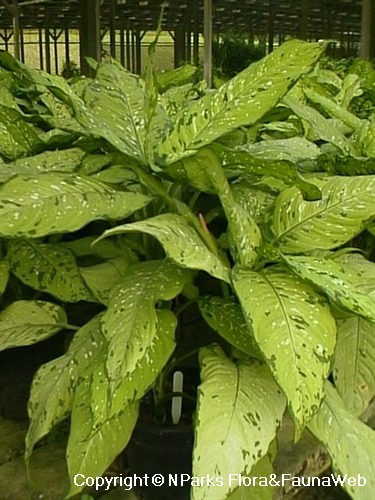
Back
Dieffenbachia amoena
| Family Name: | Araceae |
| Common Name: | Dumb Cane, Besar Putih |
Dumb Cane (Dieffenbachia amoena) is a robust herbaceous shrub with usually unbranched fleshy stems and large elliptic leaves arching gracefully from the upright stems. It is commonly grown for its foliage which has interesting patterns and markings, especially as an indoor or houseplant.
Name
Classifications and Characteristics
| Plant Division | Angiosperms (Flowering Seed Plants) (Monocotyledon) |
|---|---|
| Plant Growth Form | Shrub |
| Lifespan (in Singapore) | Perennial |
| Mode of Nutrition | Autotrophic |
Biogeography
| Native Distribution | Tropical America |
|---|---|
| Native Habitat | Terrestrial |
| Preferred Climate Zone | Tropical |
| Local Conservation Status | Non-native |
Description and Ethnobotany
| Growth Form | A robust herbaceous shrub with usually unbranched fleshy stems and large elliptic leaves arching gracefully from the upright stems. |
|---|---|
| Foliage | Glossy dark green with creamy white to yellow lines, spots, or patches. Large (up to 45cm long, elliptic to slightly lanceolate, smooth, entire margins. |
| Others - Plant Morphology | The sap of this plant is poisonous and must not be allowed to come into contact with the mouth or eyes. The calcium oxalate crystals in the sap cause irritation and swelling of the tissues in the mouth and throat, resulting in possible loss of speech for several days (hence the common name Dumb Cane). To date, there are no known cases of death from ingestion or through contact of these plants. In addition, this plant species has been a popular indoor plant for a very long time due to its ease of maintenance and ability to tolerate low light conditions in the house or office. In circumstances where there are young children and animals, precautions can be taken by placing or relocating the plants out of their reach to avoid accidental or unintentional ingestion or contact of the sap upon breakage of the plant parts. |
| Cultivation | Hardy plants that require little maintenance. They prefer bright filtered light but are able to tolerate dark conditions, however, variegation may be lost if they are kept in the shade for prolonged periods. Prefer slightly acidic, moist soil. Soil high in coco peat is ideal. Soil should be allowed to dry slightly before watering. |
Landscaping Features
| Landscaping | Very commonly grown for its foliage, which has interesting patterns and markings, especially as an indoor or houseplant. |
|---|---|
| Desirable Plant Features | Ornamental Foliage |
| Landscape Uses | Interiorscape/ Indoor Plant |
| Usage Hazard - Cons | Irritant - Sap, Toxic Upon Ingestion |
Plant Care and Propagation
| Light Preference | Semi-Shade |
|---|---|
| Water Preference | Occasional Misting, Lots of Water |
| Plant Growth Rate | Fast to Moderate |
Foliar
| Foliage Retention | Evergreen |
|---|---|
| Mature Foliage Colour(s) | Green, Yellow / Golden |
| Mature Foliage Texture(s) | Leathery |
| Prominent Young Flush Colour(s) | Green, Yellow / Golden |
| Young Flush Texture(s) | Glossy / Shiny, Leathery |
| Foliar Type | Simple / Unifoliate |
| Foliar Arrangement Along Stem | Alternate |
| Foliar Attachment to Stem | Petiolate |
| Foliar Shape(s) | |
| Foliar Venation | Pinnate / Net |
| Foliar Margin | Entire - Wavy / Undulate |
| Leaf Area Index (LAI) for Green Plot Ratio | 3.5 (Shrub & Groundcover - Monocot) |
Floral (Angiosperm)
| Flower & Plant Sexuality | Bisexual Flowers |
| Flower Grouping | Cluster / Inflorescence |
|---|---|
| Inflorescence Type | Spathe & Spadix |
Image Repository
Others
| Master ID | 638 |
|---|---|
| Species ID | 1933 |
| Flora Disclaimer | The information in this website has been compiled from reliable sources, such as reference works on medicinal plants. It is not a substitute for medical advice or treatment and NParks does not purport to provide any medical advice. Readers should always consult his/her physician before using or consuming a plant for medicinal purposes. |




